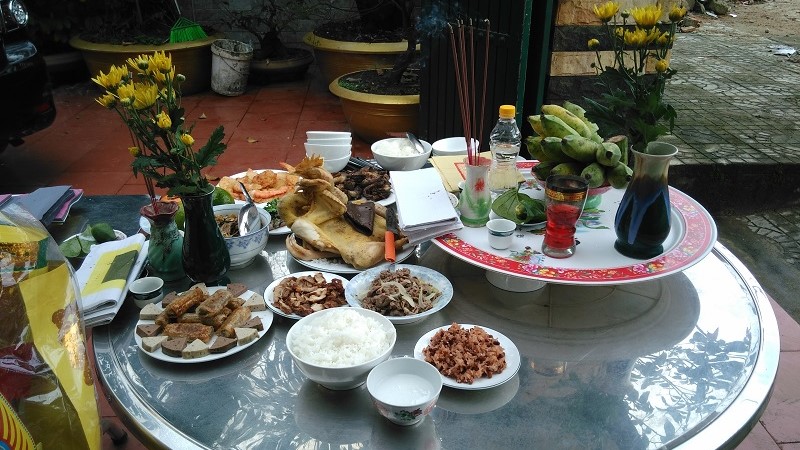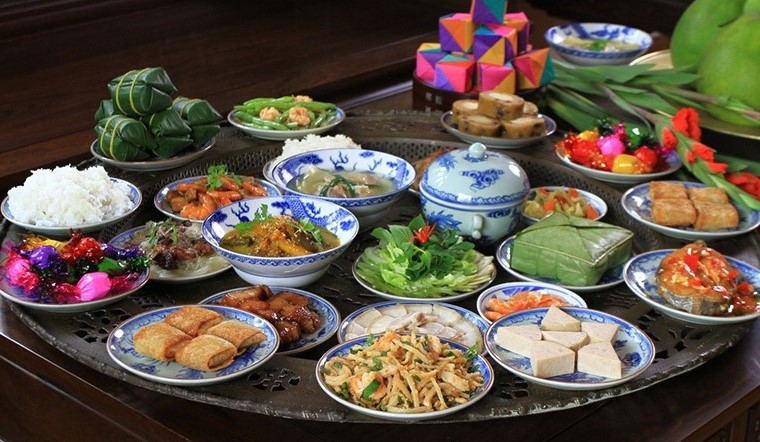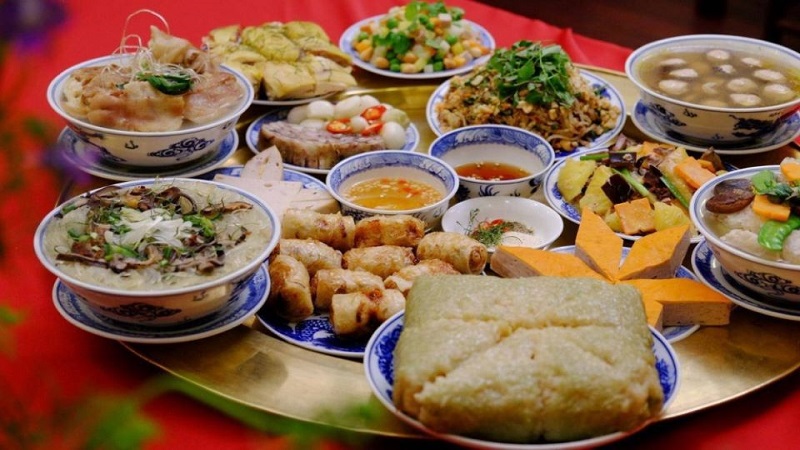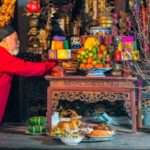The transition from the old year to the new year is a busy time for families with many tasks to complete. One of the most important things to pay attention to is the end-of-year rituals and ceremonies. Let’s explore the meaning of these traditional Vietnamese year-end rituals and ceremonies!
1 End-of-Year Land Worship Ceremony
, also known as the end-of-year worship ceremony for the God of Land, is usually held before the Kitchen God Day and after the full moon of the twelfth lunar month.
For Vietnamese people, the God of Land, also known as the Earth God or Thổ Địa, is the deity who governs a particular plot of land. As the most important deity in the family, people must pray to the God of Land for permission when inviting their ancestors’ spirits back home.
 End-of-Year Land Worship Ceremony
End-of-Year Land Worship Ceremony
This ceremony expresses gratitude to the God of Land, ancestors, and household deities, while also seeking their blessings and protection for a peaceful and prosperous new year.
In Vietnamese culture, both historically and in the present day, showing gratitude to the deities of the land one inhabits is of utmost importance. It is believed to have a spiritual impact on the people living and working on that land, in that apartment or house, etc.
2 End-of-Year Repayment Ceremony
The End-of-Year Repayment Ceremony, or “le ta”, involves “borrowing luck” at the beginning of the year and “repaying” at the end. Thus, at the beginning of the year, the host family should visit the temple, pagoda, or palace to hold a ceremony to pray for blessings, and at the end of the year, they should go to the same place to hold a ceremony to repay their gratitude.
According to folk beliefs, it is customary to visit temples and pagodas at the beginning of the year to pray for luck, borrow blessings, and then, even if busy or ill, make time to hold a ceremony to repay the blessings at the end of the year. This is not only a folk belief but also reflects the tradition of “remembering the source of water” of the Vietnamese people.
It is also believed that “what you take, you must give back”. When you receive blessings from the Saints, you must show your gratitude and reciprocate. An ungrateful person will not receive any more blessings and will never experience anything good. Repaying the blessings brings peace of mind and welcomes the new year with more luck.
3 Year-End Ceremony
The Year-End Ceremony, or Tất Niên, is one of the year-end ceremonies that marks the end of the old year and the beginning of the new one. It is held on the afternoon of the 30th of the Lunar New Year.
 Year-End Ceremony
Year-End Ceremony
The Year-End Ceremony is an age-old custom and a unique feature of Vietnamese culture. After a year of hard work, family members gather together and prepare to welcome the new year with the Year-End Ceremony dinner. Therefore, the offerings for this ceremony should be simple and heartfelt, consisting of dishes that are close to the family’s heart.
Nowadays, families hold the Year-End Ceremony indoors to create a cozy atmosphere and express their gratitude to the deities and their ancestors.
4 New Year’s Eve Ceremony
The New Year’s Eve Ceremony, or Trừ Tịch, is a ritual that aims to drive away evil spirits and bad luck. It is held from 11:00 PM to 1:00 AM, at the turning point between the old and new years. Hence, it is also known as the “turn of the year” ceremony.
The meaning of this ceremony is to shed all the bad and unhappy things of the past year and welcome the good things of the new year. In addition to holding the ceremony at home, Vietnamese people also set up an outdoor offering to celebrate the New Year.
 New Year’s Eve Ceremony
New Year’s Eve Ceremony
5 Ceremony for Sending off the Kitchen God
The Ceremony for Sending off the Kitchen God, or Táo Quân, is held annually on the 23rd of the twelfth lunar month. The host family prepares offerings, paper money, and gold, along with paper carp or live carp, and then performs the ceremony to send off the Kitchen God to heaven.
 Offering for Sending off the Kitchen God
Offering for Sending off the Kitchen God
According to ancient Vietnamese beliefs, the Kitchen God, or Táo Quân, ascends to heaven to report to the Jade Emperor about the good and bad deeds of the family in the past year. Therefore, the ceremony to send off the Kitchen God is held solemnly, and the custom of worshipping the Kitchen God at the end of each year originates from this belief.
6 Full Moon Ceremony of the Twelfth Lunar Month
Annually, there are three full moon days considered major: the first full moon of the first lunar month, the seventh full moon, and the twelfth full moon. The twelfth full moon, or the full moon of the twelfth lunar month, is considered the end-of-year full moon ceremony.
According to Vietnamese customs, families usually hold the ceremony on the afternoon of the 14th of the lunar month or the morning of the 15th. The offerings for this ceremony are carefully prepared.
 Offering for the Full Moon Ceremony of the Twelfth Lunar Month
Offering for the Full Moon Ceremony of the Twelfth Lunar Month
The offerings can be vegetarian or non-vegetarian, and many places offer family meals as well. For vegetarian offerings, families can present fresh flowers,, betel and areca nuts, clean water, and fruits, or oil lamps, paper money, and gold to the deities and ancestors.
For non-vegetarian offerings, families can prepare boiled chicken, sticky rice, square glutinous rice cakes, , other savory dishes, and . According to folk beliefs, a rooster symbolizes intelligence, courage, and humanity. Therefore, on ceremonial occasions, Vietnamese people often include a rooster in their offerings.
This article has explained the meaning of various traditional Vietnamese year-end rituals and ceremonies. Hopefully, this information is helpful, and please look forward to our upcoming articles!
New Year’s Eve Offering for the Year of the Dragon 2024: Customs, Rituals, and Prayers
The Vietnamese tradition of offering a farewell to the old year and welcoming the new one is celebrated with an ancestral worship ritual called the New Year’s Eve Ceremony. This ceremony, also known as the “Ceremony of Dismissing the Old Age,” takes place on the eve of the Lunar New Year, around 11 p.m. on the 30th of the twelfth lunar month. It is a time when families bid farewell to the passing year and invite their ancestors to join them in welcoming the arrival of a prosperous and fortunate new year.


































